Page 2: Damselflies that are NOT in the Pond Damsel family
- Spreadwings, Broadwings, and Shadowdamsels -
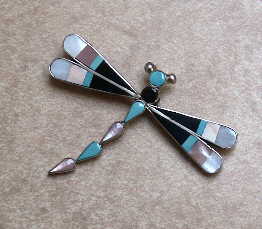
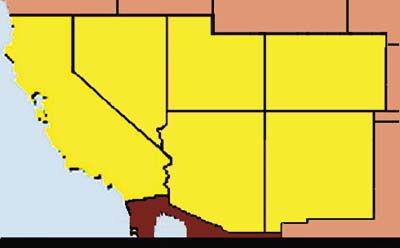

Damselflies (Zygoptera) of the Southwest
Page 2: Damselflies that are NOT in the Pond Damsel family
- Spreadwings, Broadwings, and Shadowdamsels -



|
Updated May 2019 Dragonflies of California and the Greater Southwest, A Beginner's Guide by Kathy Biggs 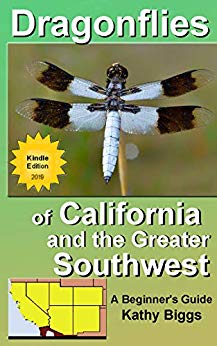
by Kathy Biggs - Price $7.99 .... |
Dragonflies of North America, A Color and Learn Book with Activities Kathy Biggs and Tim Manolis Click to 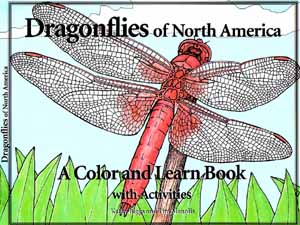
see more information about or buy the book. First published June 2007, updated 2021. For children, grandchildren & your inner child! |
Enter the on-line guide below
Click on image/word to be taken to that kind of Damselfly
This site is 100% privately maintained. If you've found it helpful, a donation to help keep in on the web would be appreciated, thanks! K. Biggs
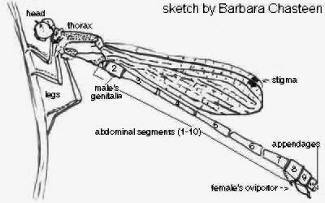
Sketch of a damselfly showing the body parts by Barbara Chasteen |
DAMSELFLIES - ZygopteraSlender-bodied, generally smaller and more frail than dragonflies. Most have an eyespot in back of each eye. When perched, all four wings are usually held together alongside or sail-like over the abdomen. Eyes set far apart on head, appear hammer headed. Weak fliers, usually found not too far from water. Males have a bump (genitalia) under their 2nd abdominal segment and four terminal abdominal appendages. Females have a wide ovipositor on the underside at the end of their abdomen and only two terminal abdominal appendages. Damselflies lay their eggs directly into vegetation. The SW has 16 genera representing all 5 North American families: 1. Pond Damsels - Coenagrionidae [This takes you back to page 1] 2. Shadowdamsels - Platysticidae 3. Spreadwings - Lestidae 4. Broad-winged Damsels - Calopterygidae |
Directions: Click on the image that looks the most like the damselfly you want to learn more about, or just scroll
down the page to find the damselfly that looks the most like the one you'd like to find out more about.
Damselflies are arranged within family by predominant color within genus. There are 2 pages of damselfly images.
Pond Damsels were on page 1. Damselflies in the other families are on this second page.
Use your back button to return to this page
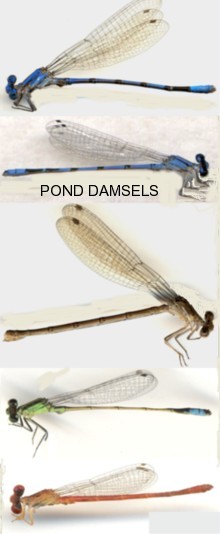
Pond Damsels (Coenagrionidae) This link returns you to Page 1 of the SW Damselflies 63 species |
This is on this page, Page 2

Spreadwings (Lestidae) 12 species |
This is on this page, Page 2
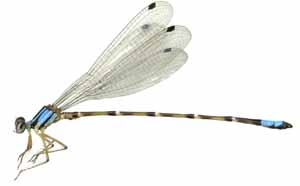
Shadowdamsels (Platysticidae) Only one species This is on this page, Page 2 Only one species |
This is on this page, Page 2
. 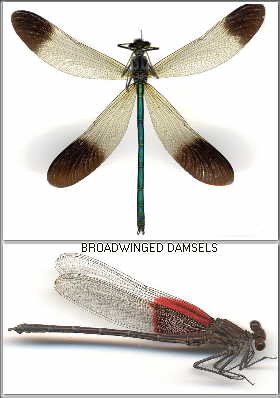
Broadwinged Damsels (Calopterygidae) 5 species |

Scan by Ed Lam |
Shadowdamsels: Platysticidaesizes: medium, length 35 - 45 mm males: long narrow abdomens females: like male or tan habitats: arid desert streams with riparian edges behaviors: shy; active during cooler periods of day/weather; hide in crevises in banks of waterways. SW flight period - July - Sept. only one species found in USA |
|
Photos male - AZ male - AZ male - AZ male & female - AZ multiple images - AZ multiple images - AZ multiple images - AZ female - AZ multiple images - AZ/MX multiple images - AZ/MX Scans male - AZ female - AZ |
Desert Shadowdamsel Palaemnema domina
size: medium, length 35 - 45 mm male: very long narrow abdomen with pale rings; tips of clear wings don't extend beyond segment 6; no eyespots; blue prothotax; middle abdominal segments have small triangular streaks on side near front of each segment; segments 8-10 blue with lower black margin; similar to Kiowa Dancer but blue female: like male or tan but less blue at tail tip; clear wings habitat: arid desert streams SW flight period: July 5 - September 21 behavior: shy; hides in dark areas such as small caves SW distribution: AZ (rare) Southwestern distribution map |

Spreadwings are arranged within genus by similarity in markings. |
Spreadwings - Lestidaesizes: medium to large, slender; lengths: 30 - 62 mm 2 SW genera: Pond Spreadwings - 10 SW species Stream Spreadwings - 2 SW species males: dark with blues, greens; blue eyes; pruinose pale area near tip; some show more extensive pruinosity females: more stout; less colorful; not pruinose habitats: ponds, marshes, streams, slow rivers behaviors: often hold wings open when at rest, la stealth bombers; oviposit in plant tissue that is above water level Pond Spreadwings, Lestes: found flying at still water sites summer through fall; patrol shoreline from emergent vegetation on which they rest; oviposit while in tandem into non-woody vegetation above the water level Stream Spreadwings, Archilestes: moving water sites; SW's largest damselflies; tandem oviposit into woody vegetation such as bay, alder & willow branches overhanging creeks/small rivers (even when dry); late season flight |

Image by Ray Bruun Comparison of 4 common species |
GENUS: Lestes Pond Spreadwings - 10 SW species
sizes: long and slender; 30 - 53 mm
|
| Photos
multiple images - AZ male - CA male - CA multiple images - CA multiple images - CA male - CO male - CO male - NM male - NM male - NM male & pair - NM pair - NM Scans male - CA male - CA male - CA male - CA male - CA male - CA male - CA male side - CA pair - CA female - CA female - CA male - OR |
Northern [formerly Common, species recently split] Spreadwing Lestes disjunctus disjunctus
size: medium, slender, length 30 - 40 mm male: blue eyes; thorax becomes pruinose pale blue; first two and last two or three abdominal segment become pruinose gray-blue; other segments have dark/green sheen; lower appendages long & straight but may be held crossed or like a V (examine carefully with hand lens); black stigma female: more stout; no pruinosity; ovipositor does NOT extend beyond end of abdomen habitat: weedy ponds, streams SW flight period: April 19 - November 21 SW distribution: all Southwest Southwestern distribution map Information on California Odonata website |
| Photos
male - CO male - CO male - NM male - NM male - NM male - NM male - NM male - NM female - NM multiple images - TX YouTube video of a mating pair - MO Scans male - LA young male - LA female - MS |
Southern [formerly Common, species recently split] Spreadwing Lestes australis
size: medium, slender, length 36-46 mm male: blue eyes; thorax becomes pruinose pale blue; first two and last two or three abdominal segment become pruinose gray-blue; other segments have dark/green sheen; lower appendages long & straight female: more stout; no pruinosity; ovipositor does NOT extend beyond end of abdomen similar species: compare by appendages to Northern Spreadwing which has darker color pattern, smaller size (33-40 mm ) and more strongly developed tooth on the cerci habitat: Still or slow moving waters with moderate vegetation, both permanent or ephemeral ponds SW flight period: May 4 - October 5 SW distribution: CO, NM Southwestern distribution map |
| Photos
male - CO pair- CO female - CO male - OR pair & male - OR multiple images - TX multiple images - NM multiple images drawings Scans pair- OR male - WA male - WA female - WA |
Sweetflag Spreadwing Lestes forcipatus
size: medium, slender, length 30 - 42 mm male: very similar to Northern Spreadwing; blue eyes; thorax becomes pruinose pale blue; first two and last two or three abdominal segment become pruinose gray-blue; other segments have dark/green sheen; lower appendages long & straight but may be held crossed or like a V (examine carefully with hand lens); black stigma. female: easier to tell from Common Spreadwing than male is - large distinctive ovipositor extends beyond end of abdomen similar species: Extremely similar to Northern Spreadwing, esp. the males habitat: sedge fens behaviorlays eggs in stems of Sweetflag which is a kind of aquatic iris, hence the common name SW flight period: July 18 - August 15 SW distribution: CO (rare) Southwestern distribution map |
| Photos
male - AZ multiple images - AZ male - TX male - TX male - TX male - TX males & females - TX males & females - Jalisco, MX Scans male female |
Chalky Spreadwing Lestes sigma...new to SW 2013
size: medium, slender, length 34 - 45 mm male: blue eyes & face; thorax become pruinose pale blue/gray; abdominal segments 1 & two-thirds of 2, and 8, 9 & often 10 become pruinose pale blue/gray; other segments metallic brown on top; bi-colored stigma is distinctive female: can become pruinose at maturity; immature pale brown; bi-colored stigma similar species: similar to Northern, Southern & Sweetflag Spreadwings, esp. the males. These lack bi-colored stigma. habitat: shallow marshes & ponds with emergent vegetation, even ones that become dry sporadically. behaviorlays eggs in stems of sedges & grasses at water's edge or where water will be. SW flight period: September 5-September 15 SW distribution: AZ (rare, please report) Southwestern distribution map |
| Photos
multiple images - AZ male - CA male - CA male - CA female - CA pair - CA multiple images - CA multiple images - CA male - NM male - NM male - NM male - NM male - NM pair - NM pair & male - NM male - NV male - NV female - NV female underside - NV female underside - NV multiple images male - UT multiple images female - UT multiple images female - UT Scans male - CA male - CA male - CA female - CA female - CA female - NV |
Spotted Spreadwing Lestes congener
size: medium, slender, length 31 - 42 mm male: blue eyes; thorax dark; first & last two abdominal segments pruinose gray-blue; other segments - dark or green sheen; short lower appendages <50% of uppers; 4 dark spots thorax underside, usually visible also in side view; dark brown stigma female: more stout; less colorful habitat: weedy ponds, streams SW flight period: May 14 - December 12 SW distribution: all Southwest Southwestern distribution map Information on California Odonata website |
| Photos
male - CA female - CA female - CA multiple images - CA multiple images - CA male - CO male - CO male - CO male - CO male - CO pair- CO male's appendages Scans male - CA male - CA male - CA male - CA male - CA male - CA male - CA |
Lyre-tipped Spreadwing Lestes unguiculatus
size: medium, slender, length 31 - 42 mm male: blue eyes; thorax dark; first & last two abdominal segments pruinose gray-blue; other segments - dark or green sheen; lower appendages lyre-shaped; dark brown stigma female: more stout; less colorful habitat: weedy ponds, streams SW flight period: June 4 - October 5 SW distribution: CA, CO, NV, UT Southwestern distribution map Information on California Odonata website |
| Photos
male - CO male - CO info - North East female - OK Scans male female |
Slender Spreadwing Lestes rectangularis
size: medium/large, slender, length 42 - 53 mm male: blue eyes and face; thorax dark with pale shoulder stripe, pale yellow below; abdomen entirely dark bronzy with NO PALE SPOT on 'tail'; lower appendages curve downward; long slender abdomen, almost twice the length of the wings, is distinctive among the Spreadwings female: more stout; duller habitat: slow waters including temporary and shaded ponds and marshes SW flight period: June 4 - August 1 SW distribution: CO Southwestern distribution map |
| Photos
male - AZ male - AZ multiple images - AZ female - AZ multiple images - AZ male - NM male - NM male - NM female - NM teneral female & males - NM pair - NM pair - NM pair - NM multiple images - TX male Scans male - AZ male - AZ male - AZ |
Plateau Spreadwing Lestes alacer
[please note, photo of male in Common Dragonflies of the Southwest - 2004 is incorrect! - KB] size: medium, slender, length 34 - 45 mm male: broad dark stripe top of thorax, dark side stripe variable width; pale side stripe usually a blue tint & narrowing to a point at rear; abdomen slender, esp. middle segments; reduced dark markings abdomen top; segments 1 & 2, 8-10 become pruinose with age; lower appendages 75% of uppers female: similar to male habitat: grass-edged ponds, slow streams at low elevations SW flight period: January 27 - November 10 SW distribution: AZ, CO, NM, UT (rare) Southwestern distribution map |
| Photos
multiple images - AZ male - CA female - CA female - CA multiple images - CA male - CO male - CO male - CO female - CO female - CO pair - CO male - NM male - NM male - NV male - NV female - NV female - UT Scans male - CA male - CA male - CA male - CA female - CA female - CA |
Emerald Spreadwing Lestes dryas
size: medium, slender, length 32 - 40 mm male: top of thorax bright metallic green; sides of thorax blue; abdomen bright metallic green; first two and last two segments can show blue; appendages are long and broad at the end female: stocky; less emerald habitat: forested mountain areas SW flight period: April 22- October 2 SW distribution: all Southwest Southwestern distribution map Information on California Odonata website |
| Photos
male - CA male - CA male - CA male - CA male - CA immature male - CA female - CA teneral female - CA pair ovipositing - CA multiple images - CA Scans male - CA female - CA females - CA |
Black Spreadwing Lestes stultus
size: medium, slender, length 35 - 44 mm male: very similar to Emerald Spreadwing except black not green coloration; bronzy thorax when immature; first two and last two segments can show pruinose blue; appendages are long and broad at the end female: stocky habitat: sloughs, ditches, ponds SW flight period: March 27 - September 5 SW distribution: CA Southwestern distribution map Information on California Odonata website |

Image by Dave Biggs |
GENUS: Archilestes Stream Spreadwings - 2 SW species
sizes: very long and slender; 42 - 62 mm
|
| Photos
male - AZ male - AZ multiple images - AZ multiple images - AZ pair - AZ pair - AZ male - CA male - CA male - CA male - CA male - CA male - CA male - CA male - CA female - CA female - CA pair ovipositing - CA pairs ovipositing - CA multiple images - CA multiple images - CA multiple images - CA Scans male - CA male - CA male - CA |
California Spreadwing Archilestes californicus
size: medium/large, slender, length 42- 59 mm male: long body brown &/or black with pruinose area near tip; 2 incomplete white stripes thorax sides; blue eyes & face; wings colorless, stigma from top usually pale; upper appendages semicircular and lower appendages can be seen from top view, lower are parallel; late season flier female: less colorful brown tones similar species: Great Spreadwing has complete pale thoratic stripe habitat: streams with alders/willows SW flight period: May 23 - February 17 SW distribution: AZ, CA, NV, NM Southwestern distribution map |
| Photos
male - AZ male - AZ male - AZ male - AZ male - AZ appendages- AZ multiple images - AZ female - AZ female - AZ female - AZ female - AZ female - AZ male - CA male - CA male - CA young male - CA pairs ovipositing into Bay Tree branches - CA female - CA female - CA female - CA male - CO male - CO female - CO female - CO male - NM male - NM male - NM male - NM male - NM male - NM male - NM female - NM female - NM male & pair - NV Scans male - CA male - CA female - CA female - CA |
Great Spreadwing Archilestes grandis
size: large, slender, length 50 - 62 mm male: long body gray with greenish sheen, pruinose area near tip; one continuous pale side stripe on thorax (yellow in mature); blue eyes & face; stigma usually dark; top appendages semicircular, lowers divergent and can't be seen from top view; North American's largest damselfly; late season flier female: less colorful similar species: California Spreadwing has incomplete pale thoratic stripe habitat: streams with overhanging alders/willows/bay SW flight period: March 21 - January 17 SW distribution: all southwestern states Southwestern distribution map Information on California Odonata website |

|
Broad-winged Damsels - Calopterygidaesizes: medium to large, slender; lengths: 36 - 54 mm; 2 SW genera: Jewelwings - 2 SW species Rubyspots - 3 SW species males: large for damselflies; colorful patches in wings females: more stout; less colorful bodies and wings habitats: streams, slow rivers, esp. with vegetation behaviors: butterfly-like courtship &/or male display flights; perch horizontally, head down on vegetation, shoreline rocks Jewelwings, Calopteryx: large broad wings with black wing coloration either at tip of or for entire wing; beautiful green and blue iridescent coloration on body changes with angle of viewing; long spindly legs; courtship displays Rubyspots, Hetaerina: males have basal quarter to third of wings with beautiful red patches; thorax matures to red as seen through smoky glass or to dark with reddish iridescence; very long dark legs; males duel in display flights |

Image by Ray Bruun |
GENUS: Calopteryx Jewelwings - 2 SW species
sizes: medium; 43-54 mm
|
| Photos
male - CA male - CA male - CA pair in cop - CA female - CA female - CA female - CA immature female - CA multiple images - CA multiple images - CA photos of behaviors - CA pair in wheel - CA male - NV male - NV nymph Scans male - CA male - CA male - CA female - CA female - CA male - OR |
River Jewelwing Calopteryx aequabilis
size: medium, length 43 - 54 mm male: jewel-like bright metallic green/blue thorax and abdomen; outer 1/3 of wings conspicuously dark female: duller abdomen, pale tip; smoky wings have a contrasting pale pseudostigma; sometimes oviposit under water habitat: fast waters of large wooded streams/rivers; larva live in root masses behavior: males display for females over the water SW flight period: May 6 - August 11 SW distribution: CA, CO, NV, UT Southwestern distribution map Information on California Odonata website |
| Photos
male - CO male - CO male - CO male & pair - CO female - CO male - NY multiple images - TX multiple images - MN male - NJ female - NJ male - WI female - WI Scans |
Ebony Jewelwing Calopteryx maculata
size: medium, length 39 - 57 mm male: jewel-like bright metallic green/blue thorax and abdomen; wings all dark, including stigma female: duller abdomen, pale tip; wings all pale brown, darker towards tips, conspicuous white pseudostigma habitat: fast waters of large wooded streams/rivers; larva live in root masses SW flight period: June 22 - September 1 SW distribution: CO Southwestern distribution map |
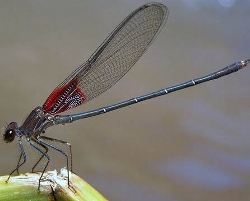
Image by Pierre Deviche |
GENUS: Hetaerina Rubyspots - 3 SW species
sizes: medium; 36-51 mm
|
| Photos
male - AZ male - AZ multiple images - AZ multiple images - AZ multiple images - AZ female - AZ teneral female - AZ male - CA male - CA male - CA male - CA male - CA female - CA female - CA female - CA multiple images - CA multiple images - CA female - CO female - CO male - NM male - NM male - NM male - NM female - NM male & appendages - NV male - NV male - NV female - NV female - NV male - UT multiple images male - UT male - UT multiple images female - UT Scans male - CA male - CA male - CA female - CA male - NM male - UT female - UT |
American Rubyspot Hetaerina americana
size: medium/large, length 36 - 51 mm male: wings ruby red basal 1/3 to 1/2; thorax top blood red as if under black glass, pale side stripes; abdomen bronzy brown-green with thin rings; CA usually no stigma, other states pale stigma female: less colorful; wings with orangish streak on leading edge, tips mostly clear, pale stigma (sometimes no stigma in CA) similar species: very similar to Canyon Rubyspot, which has smoky edged wing-tips: here is a comparison site behavior: males hold territory at moving water sites; often perch with head lower than abdomen & wings held together to one side of abdomen habitat: open streams, rivers SW flight period: capable of flight all year in appropriate weather in the south SW distribution: all Southwestern states Southwestern distribution map Information on California Odonata website |
| Photos
male - AZ male - AZ male - AZ male - AZ male - AZ male - AZ male - AZ males - AZ multiple images - AZ multiple images - AZ multiple images - AZ comparison shot Am. & Canyon females - AZ female - AZ female - AZ female - AZ male - NM male - NM male - NM male - NM female - NM pair - NM male - UT Scans |
Canyon Rubyspot Hetaerina vulnerata
size: medium/large, length 36 - 49 mm male: red at wing base usually less extensive than American Rubyspot's; smoky edge/wing-tip; no stigma; compare by appendages American - upper appendages 1-2 toothlike lobes inside at midpoint; Canyon lacks these lobes female: less colorful; wing patches orangish, no stigma, smoky wing tips: here is a comparison site behavior: males hold territory at moving water sites; usually don't hold wings together to one side of abdomen as Am.Rubyspots do habitat: canopied streams, rivers SW flight period: March 8 - December 23 SW distribution: AZ, NM, NV, UT Southwestern distribution map |
| Photos
male - TX male - TX multiple images - TX multiple images - TX multiple images, drawings multiple images - Jalisco, MX Scans male top - TX male side - TX male side - TX male - LA female - LA |
Smoky Rubyspot Hetaerina titia (this may be only historical and may no longer found in SW)
size: medium/large, length 37 - 51 mm male: quite variable; wings mostly dark with red at base of forewing; abdomen mostly black, without rings female: less colorful behavior: males hold territory at moving water sites; usually don't hold wings together to one side of abdomen as Am.Rubyspots do habitat: sandy-bottomed streams, rivers SW flight period: June 6 - August 18 SW distribution: AZ Southwestern distribution map |
Click here to return to the Page 1 of Damselflies page where the Pond Damsels are covered.
I'm glad you enjoy the dragonflies and damselflies too! THANK-YOU for visiting!!
Kathy Biggs, Azalea Creek Publishing
Email Kathy Biggs
This site is 100% privately maintained. If you've found it helpful, a donation to help keep in on the web would be very much appreciated, thanks! K. Biggs